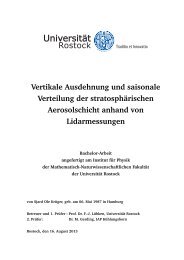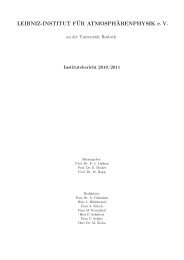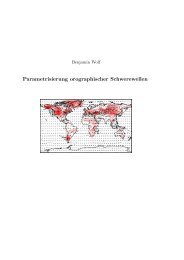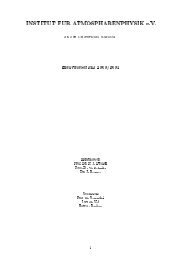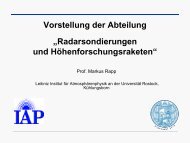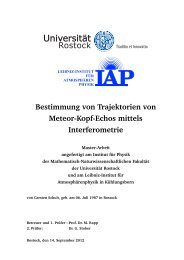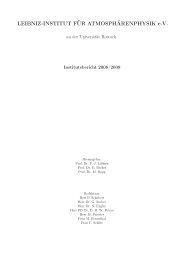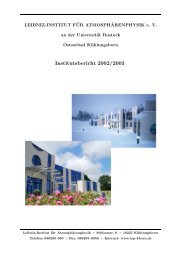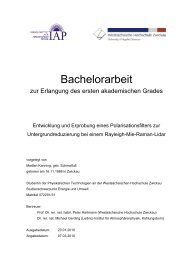Polar mesosphere summer echoes (PMSE): review of ... - HAL
Polar mesosphere summer echoes (PMSE): review of ... - HAL
Polar mesosphere summer echoes (PMSE): review of ... - HAL
Create successful ePaper yourself
Turn your PDF publications into a flip-book with our unique Google optimized e-Paper software.
M. Rapp and F. J. Lübken: Review <strong>of</strong> <strong>PMSE</strong> 2615<br />
would be observed by a lidar at 532 nm wavelength (BSR<br />
= total received signal at a certain altitude divided by the<br />
signal due to pure molecular Rayleigh scattering. BSR>1<br />
when Mie scattering due to ice particles enhances the scatter<br />
significantly over the Rayleigh background). The maximum<br />
brightness is reached at altitudes <strong>of</strong> ∼81.5 km with<br />
corresponding particle radii <strong>of</strong> ∼40 nm and number densities<br />
<strong>of</strong> 50–100 cm −3 . These numbers are generally consistent<br />
with values derived from multi-color lidar observations<br />
by von Cossart et al. (1999). Figure 18a further shows that<br />
the formation and growth <strong>of</strong> the ice particles leads to significant<br />
redistribution <strong>of</strong> water vapor due to the freeze drying<br />
effect (because the ice particles ‘consume’ the available water<br />
vapor when they grow) and subsequent deposition <strong>of</strong> the<br />
ice contained water vapor at the bottom <strong>of</strong> the cloud. Note<br />
that recent satellite water vapor measurements indeed find<br />
evidence for this local water vapor maximum at the cloud<br />
bottom height (e.g., Summers et al., 2001; McHugh et al.,<br />
2003).<br />
Besides these studies that aimed at understanding the general<br />
microphysics, progress has also been made in the modeling<br />
<strong>of</strong> large scale and even global structures <strong>of</strong> these ice<br />
clouds. In particular, Berger and von Zahn (2002) and von<br />
Zahn and Berger (2003) have recently presented the first<br />
model study <strong>of</strong> global features <strong>of</strong> the mesospheric ice particle<br />
population by combining a microphysical ice particle<br />
model with a 3-dimensional general circulation model <strong>of</strong> the<br />
middle atmosphere.<br />
3.2 Aerosol charging<br />
As seen in Sect. 2.4.4, mesospheric ice particles modify the<br />
charge balance <strong>of</strong> the ionospheric D-region plasma. This is<br />
particularly evident from the observations <strong>of</strong> strong depletions<br />
in the electron number density at <strong>PMSE</strong> altitudes which<br />
show that the aerosol particles act as a sink for the electrons<br />
and hence become negatively charged. Reid (1990) was the<br />
first to consider this process quantitatively: based on the electron<br />
and positive ion capture rates due to Natanson (1960)<br />
he studied the concentration <strong>of</strong> singly and doubly charged<br />
ice particles and the feedback <strong>of</strong> their charging on the background<br />
electron and positive ion number density as a function<br />
<strong>of</strong> the number density <strong>of</strong> available ice particles. Keeping also<br />
the ice-equivalent water vapor content inside reasonable limits,<br />
Reid (1990) concluded that several thousand ice particles<br />
per cubic-centimeter with a radius <strong>of</strong> ∼10 nm were the most<br />
likely candidate to explain the observed biteouts in the free<br />
electron number density. Consequently, most <strong>of</strong> the ice particles<br />
should be singly negatively charged. The drawback <strong>of</strong><br />
this study, however, was its restriction to singly and doubly<br />
charged particles such that Jensen and Thomas (1991) developed<br />
this model further by allowing for an arbitrary negative<br />
particle charge and derived the statistical charge distribution<br />
as a function <strong>of</strong> particle radius for standard background conditions<br />
<strong>of</strong> the D-region (production rate <strong>of</strong> electrons and pos-<br />
Fig. 19. Relative disturbance <strong>of</strong> electron (blue lines) and positive<br />
ion number density (green and red lines), n e and n i in percent,<br />
as a function <strong>of</strong> the particle radius, r A , and number density, N A . The<br />
calculations have been perfomed for an electron/ion production rate<br />
Q=10/(cm 3 s) and a recombination coefficient α=10 −6 cm 3 /s (Rapp<br />
and Lübken, 2001).<br />
itive ions Q=10 7 m −3 s −1 and electron-positive ion recombination<br />
rate α=10 −12 m 3 s −1 , corresponding to an undisturbed<br />
plasma density <strong>of</strong> √ Q/α≈3·10 9 m −3 which is a reasonable<br />
value for the polar D-region; Friedrich and Torkar, 2001).<br />
Jensen and Thomas (1991) found an average aerosol charge<br />
<strong>of</strong> -1e for particles with radii between 1 and 10 nm, and then<br />
a linear increase <strong>of</strong> the aerosol charge, i.e., ∼−2e for 30 nm<br />
particles and −3e for particles with a radius <strong>of</strong> 50 nm (with e<br />
being the elementary charge). These results were then further<br />
generalized by Rapp and Lübken (2001) who also systematically<br />
considered the dependence <strong>of</strong> the aerosol charge on the<br />
background plasma conditions and studied the expected response<br />
not only <strong>of</strong> the electron number density but also the<br />
positive ion number density. Figure 19 shows the change<br />
<strong>of</strong> the electron and positive ion number density relative to<br />
a background where no particles are present as a function <strong>of</strong><br />
both particle number density N A and particle radius r A . Rapp<br />
and Lübken (2001) pointed out that the ice particles leave a<br />
characteristic ‘fingerprint’ in the plasma if the effect on both<br />
electrons and ions is considered: while the electron number<br />
density is expected to be depleted for all aerosol particle parameters<br />
considered, the positive ion number density can be<br />
either depleted (when being controlled by the capture on the<br />
ice particles) or even enhanced (when being controlled by<br />
the recombination with electrons). Hence, Rapp and Lübken<br />
(2001) showed that the combined measurement <strong>of</strong> the disturbance<br />
in the electrons and ions allows for a characterization<br />
<strong>of</strong> the aerosol particles themselves. This idea was then applied<br />
by Lübken and Rapp (2001) who derived aerosol parameters<br />
like radii and number densities from the observation<br />
<strong>of</strong> positive ion and electron disturbances under <strong>PMSE</strong><br />
and/or NLC conditions. In summary, the interaction <strong>of</strong> the<br />
www.atmos-chem-phys.org/acp/4/2601/ Atmos. Chem. Phys., 4, 2601–2633, 2004



